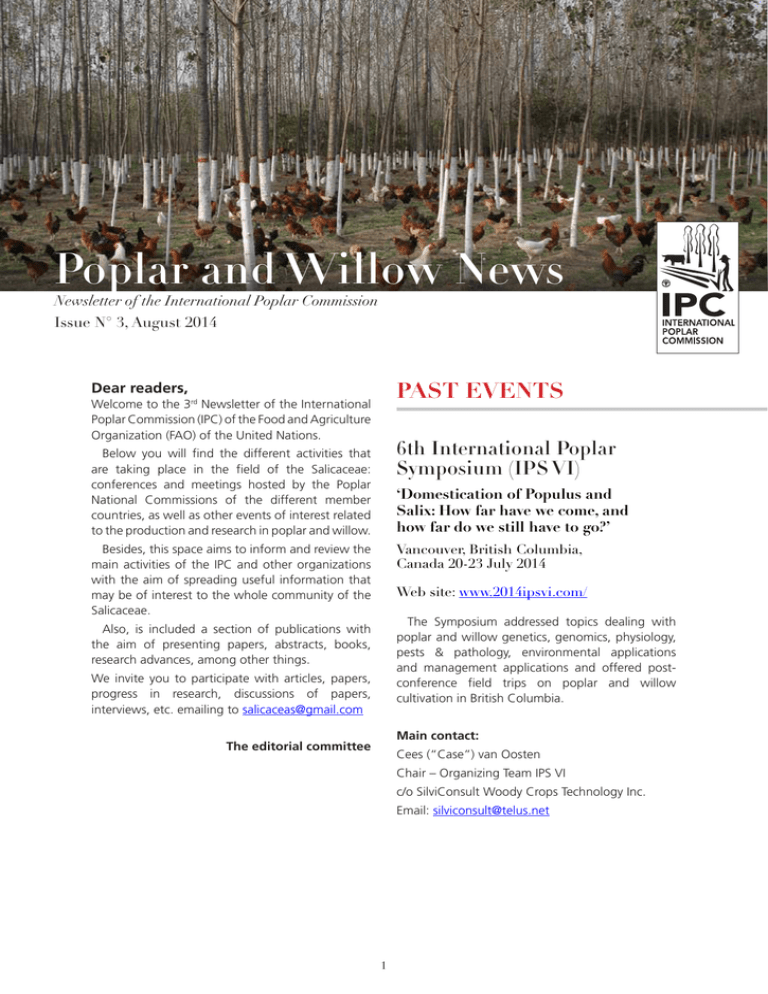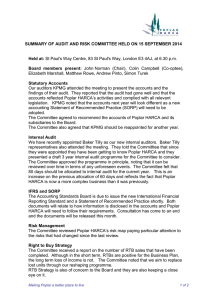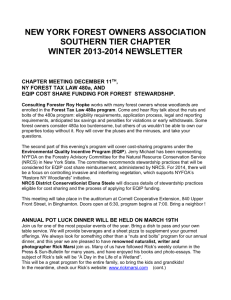Poplar and Willow News PAST EVENTS Dear readers,
advertisement

Poplar and Willow News Newsletter of the International Poplar Commission Issue N° 3, August 2014 PAST EVENTS Dear readers, Welcome to the 3rd Newsletter of the International Poplar Commission (IPC) of the Food and Agriculture Organization (FAO) of the United Nations. 6th International Poplar Symposium (IPS VI) Below you will find the different activities that are taking place in the field of the Salicaceae: conferences and meetings hosted by the Poplar National Commissions of the different member countries, as well as other events of interest related to the production and research in poplar and willow. ‘Domestication of Populus and Salix: How far have we come, and how far do we still have to go?’ Vancouver, British Columbia, Canada 20-23 July 2014 Besides, this space aims to inform and review the main activities of the IPC and other organizations with the aim of spreading useful information that may be of interest to the whole community of the Salicaceae. Web site: www.2014ipsvi.com/ The Symposium addressed topics dealing with poplar and willow genetics, genomics, physiology, pests & pathology, environmental applications and management applications and offered postconference field trips on poplar and willow cultivation in British Columbia. Also, is included a section of publications with the aim of presenting papers, abstracts, books, research advances, among other things. We invite you to participate with articles, papers, progress in research, discussions of papers, interviews, etc. emailing to salicaceas@gmail.com Main contact: The editorial committee Cees (“Case”) van Oosten Chair – Organizing Team IPS VI c/o SilviConsult Woody Crops Technology Inc. Email: silviconsult@telus.net 1 ARTICLES OF INTEREST IV International Congress of Salicaceae in Argentina "Willows and development" poplars for regional Carbon Sequestration in an Agroforestry System in Northern India The Fourth International Congress of Salicaceae in Argentina was carried out from 18 to 21 March at the Faculty of Agricultural and Forestry Sciences of the National University of La Plata. It was organized by the Ministry of Agriculture, Livestock and Fisheries of Argentina, the Argentine National Poplar Commission, the Faculty of Agricultural and Forestry Sciences of the National University of La Plata, Forest Projects of the Unit for Rural Change (UCAR), the National Institute of Agricultural Technology (INTA) and the Ministry of Agricultural Affairs of the province of Buenos Aires. by Dhillon, Ravinder S1, Beniwal, Rajender S1, von Wuehlisch, Georg 2 *Correspondence author: georg. vonwuehlisch@ti.bund.de Department of Forestry CCS Haryana Agricultural University, Hisar-125004, India 2 Thuenen-Institute for Forest Genetics, Sieker Landstr. 2, 22927 Grosshansdorf, Germany 1 The Congress was attended by more than 250 people, there were 22 presentations, including Seminars for Professional Development, Speeches and Workshops and 103 papers were presented. All the information on the IV International Congress of Salicaceae in Argentina including the technical report and the Technical papers and Communications; Dissertations and presentations, among other information is available on the official website of the Congress: http://jornadasdesalicaceas2014.blogspot.com.ar/ Additionally, a special Newsletter on the event will be published. World Agroforestry Congress 2014, India Poplar and sorghum Poplar and wheat www.wca2014.org Introduction Mr. R. C. Dhiman from the WIMCO Company, India, submitted a blogspot on the poplar program promoted by WIMCO to the World Agroforestry Congress 2014. It is available for comments from readers at the link given below: Owing to its fast growth, deciduous nature, successful intercropping, and high wood demand poplar (Populus deltoides Bartr. Ex Marsh.) has become a viable alternative to traditional irrigated rice-wheat rotation in north-western states of India and satisfies the rising requirements of the regional plywood industry. Agroforestry provides multiple ecological and economical benefits including carbon sequestration, soil and water improvement, raising species diversity and stabilizing farmer’s incomes by diversification. Experiments were conducted to study the effect of poplar spacing and row direction, suitable crop rotation as well as www.wca2014.org/blog/ It could also be viewed at www.wca2014.org. 2 the carbon sequestration potential of agroforestry as compared to sole agriculture. Furthermore, changes in soil physico-chemical properties were analysed (Chauhan et al. 2011, 2012, Gupta et al. 2009, Murthy et al. 2013). poplar-wheat system. The carbon stock in the above-ground biomass and below-ground biomass contributed 37.3 t/ha at the age of six years. 6. Water stable soil aggregates (> 0.25 mm) which harbor considerable amounts of soil organic carbon and decrease soil erosion substantially for a number of years were found up to 64 times more frequently after six years in agroforestry than under sole crops. Material and Methods Poplars were planted at different spacing (5 x 4 m, 10 x 2 m and 18 x 2 x 2 m (paired row)) and interspersed with a mixture of various crops (a) cowpea/wheat (Vigna unguiculata/Triticum aestivum), (b) sorghum/ berseem (Sorghum bicolor/Trifolium alexandrinum) and (c) fallow. In addition, poplars were planted along field boundaries in North-South and EastWest direction. The carbon storage potential of agricultural crops was equated at 50 % of the total above ground dry biomass produced by these crops during a six years rotation. The carbon storage potential of poplar at six years age was estimated by felling the trees and recording their dry biomass as well as the leaf and branch fall over the six years. 7. Six years old poplar planted on field boundaries has been found to affect the green fodder yield of sorghum up to 12 m distance and wheat grain yield up to 6 m distance from the tree line. For further information please see: https://euraf. isa.utl.pt/sites/default/files/pub/docs/georg_von_ wuhlisch.pdf Benefits and Recent Results for Shrub Willow Living Snow Fences Main Results The main results of the study can be summarized as follows: by Justin P. Heavey1 and Timothy A. Volk1. 1. The height of poplar trees was not significantly affected by different spacing neither under agroforestry nor with sole poplar land use. However, the girth of poplar under agroforestry was significantly larger than in sole poplar. = State University of New York - College of Environmental Science and Forestry, Department of Forest & Natural Resource Management, Willow Biomass Project, Syracuse, NY, USA 1 2. After six years, poplar plantations were found to attain significantly larger girth at 5 x 4 m and 10 x 2 m spacing than paired row planting (18 x 2 x 2 m). Corresponding Author: Justin P. Heavey, 1 Forestry Drive, 340 Illick Hall, Syracuse, NY 13210, United States of America, jpheavey@esf. edu, 1+ (315) 470-6775 3.Sorghum and cowpea grown for fodder during the summer season and wheat and berseem (fodder) grown during the winter season produced significantly higher yield in paired row planting than 5 x 4 m and 10 x 2 m spacings. Blowing and drifting snow on roadways can increase the cost of highway maintenance and create safety hazards for drivers. Snow and ice control costs in the United States alone are several billion dollars per year. Passive snow control methods such as snow fences can reduce the cost of mechanical and chemical controls such as plowing and salting. Structural (wooden or plastic) fences are a common practice for passive snow control that have high maintenance costs, limited life spans, and limited snow storage capacity. Living snow fences are an agroforestry practice similar to windbreaks that offer an alternative to structural fences, but often require many years after planting before snow trapping begins, can have high installation costs, and can be prone to failure if proper vegetation management 4. Poplar based agroforestry system at six years age was found to sequester 82 % more carbon than sole agriculture. The yearly rate of carbon storage was found to be 17.8 t/ha in poplar based agroforestry system and 9.8 t/ha in sole agriculture. These extremely high values result from the high temperatures in Northern India, long vegetation period, irrigation and fertilization. 5.Maximum carbon was sequestered in the 3 practices are not employed. Many of the problems associated with both structural and living snow fences can be addressed through the use of shrubwillow living snow fences (SWLSF). SWLSF are a promising alternative application for the hybrid shrub willow cultivars that have been developed through biomass breeding programs. SWLSF can provide improved snow trapping, aesthetics, and environmental performance over structural fences. Rapid growth rates, tolerance of high planting density, and multiple stems per stool allow SWLSF to trap and store large quantities of blowing snow just three years after planting, much quicker than other vegetation types commonly used for living snow fences which are generally reported to take five to seven years or longer before snow trapping begins. inserted into properly prepared ground, eliminating the need for expensive construction materials of structural fences, or expensive planting stock and planting operations for other vegetation types such as conifer trees or rooted shrubs. SWLSF can also produce numerous environmental benefits such as soil conservation, wildlife habitat, and vegetative carbon sequestration. The high branch density and rapid height growth of SWLSF provide the two vegetation characteristics most critical to snow trapping and storage. A recent study conducted by researchers at the State University of New York College of Environmental Science and Forestry (SUNY-ESF) has shown that the growth trends of SWLSF can create sufficient snow storage capacity for an average winter in most locations across New York State just three years after planting when best management practices are employed (Figure 1). A suite of critical best practices for SWLSF have been developed by SUNY-ESF to ensure this level of rapid functionality, long term survival, and maximum return on investment. These practices (which can also be applied to living snow fences of other vegetation types) include plant selection, site preparation, planting techniques, weed control, and integrated pest management. Blowing snow problems occur when fallen snow is lifted off the ground by the wind and transported towards a roadway without being disrupted, a common problem in many cold weather regions around the world. SWLSF disrupt wind patterns, trapping blowing snow in drifts before it reaches the road. A relatively small investment in properly installed and maintained SWLSF can mitigate blowing snow problems for many years, creating positive benefit-cost ratios that can far exceed those of structural fences and other vegetation types. SWLSF are relatively inexpensive to install due their ability to sprout roots and shoots from dormant stem cuttings Fig.1: A shrub-willow living snow fence in New York State just four years after planting with height and branch density sufficient to create snow storage capacity thirteen times greater than the average annual quantity of blowing snow transport at the site. 4 Fig.2: A SWLSF planted along an interstate highway in New York with at a setback distance of just 10 m and a seasonal downwind snowdrift fully contained within the setback distance between the fence and the road. Recent research results from SUNY-ESF also indicate that properly managed SWLSF continue to add excess snow storage capacity in a linear trend for many years as plants continue to grow to larger heights. The impact of excess snow storage capacity relative to the quantity of blowing snow at a site is a reduced length of the downwind snow drift that is formed between the fence and the road. This reduced drift length allows SWLSF to be safely planted in relatively close proximity to roadways at setback distances as small as 10 m (Figure 2). This is much closer to the road than the 60 - 180 m setback recommendations found in current literature and educational publication of living snow fences. Reduced setback distance allows SWLSF to be installed closer to the roadway on sites where planting space is limited, a common occurrence in New York State and other regions. Installing SWLSF at appropriate setback distances also reduces the chance of blowing snow problems occurring between the fence and the road, and reduces unnecessary and costly land acquisitions or leases. Large amounts of storage capacity also provides a buffer against extreme weather events, winters with above average snowfall, and regions with higher annual quantities of blowing snow. The recent research on SWLSF by SUNY-ESF has also yielded new models of fence growth and snow trapping potential over time that can further improve the design, function, and economic performance of SWLSF. storage capacity just three growing seasons after planting, and increasing snow storage capacity for many additional years. This early snow trapping and excess storage capacity allows SWLSF to be safely installed closer to the roadway, improving overall performance and making installations feasible and on a broader range of sites. More information, guides to best practices, and research results are available at www.esf.edu/willow/lsf Status of the development of a New Holland SRWC harvest system by M Eisenbies1, T Volk1, J Posselius2, C Foster2, R Shuren3, B Stanton3, B Summers3, J Zerpa3 = State University of New York, College of Environmental Science and Forestry, Syracuse, NY, 2= Case-New Holland America LLC, New Holland, PA, 3= GreenWood Resources Inc, Portland, OR 1 Numerous types of specialized machinery exist for harvesting short rotation woody crops (SRWC), but due to the limited scale of SRWC deployment, evolving technology, differing operational scales, and management objectives there is no dominant system. In New York State, several existing or modified harvesting platforms from throughout the world have been evaluated since 2001 for use in short rotation willow. Technical hurdles harvesters tested over the years include the durability of equipment in SRWC, low production rates and irregular feeding of stems into the harvester, limits on maximum stem sizes, and SWLSF can mitigate blowing snow problems, reducing the cost of highway maintenance and improving road safety. SWLSF offer improved snow trapping and benefit-cost ratios over both structural fences and fences of other vegetation types. Recent research shows that SWLSF can have excess snow 5 (NYSTAR). Thanks to these efforts and support, New Holland is now marketing the 130 FB coppice header for the New Holland FR 9000 series, and their new FR Forage Cruiser line, of self-propelled forage harvesters through its network of dealers in both North America and Europe. chips lacking a consistent size or quality. In 2008, Case New Holland (CNH) began development of a prototype short rotation coppice header (130FB) for their FR9000 series of forage harvesters specifically designed to cut and chip a range of SRWC such as willow, poplar, and eucalyptus (Figure 1). The header can be attached to a standard forage harvester without modification to the base unit. The performance objectives of the harvester were well matched to the requirements of shrub willow production systems and markets, specifically the ability to harvest double rows of stools containing stems up to 120 mm in diameter, and to produce 10 to 45-mm long chips at a field capacity up to 2 ha hr-1. Chipped material from the harvester should be of a quality that it can be transported directly to the biorefinery without need of further processing. Over the course of the three-year project, a test bed consisting of an FR 9060 or FR 9080 forage harvester coupled with a 130 FB coppice header has improved average harvester throughput from less than 20 Mgwet hr-1 (with well over 25% downtime) to throughputs of 70 – 90 Mgwet hr-1 in mixed willow plantations with average standing biomass ranging from 20 to 65 Mgwet ha-1 (Figure 2). The nonlinear relationship between standing biomass and throughput was an important insight gained from these trials, which have implications for this and other SRWC harvesting systems since crop limited speeds had not previously been observed. The State University of New York College of Environmental Sciences and Forestry in cooperation with GreenWood Resources (Portland, OR) and New Holland (New Holland, PA) have been conducting harvesting trials in SRWC willow and hybrid poplar plantations with the goal of improving the New Holland harvesting platform since 2010; financial support has been provided by the Department of Energy Biomass Program (USDOE-BETO), the New York State Energy Research and Development Authority (NYSERDA), and the Empire State Development Division of Science, Technology, and Innovation - Technology Transfer Incentive Program The New Holland harvesting system has resolved the inconsistent chip size issue with greater than 80% of the chips being between 25 and 45 mm in size and less than 3% being smaller than 6.4 mm in size. The consistent chip size produced by the harvester was demonstrated across 14 willow cultivars and under different weather conditions. The moisture content of 195 samples collected from harvesting trials in 2012/2013 was also very consistent (average and standard deviation of 44.4 + 2.2%) and only 0.5% of the samples had moisture content greater than 50%. Fig.1: Top left: A New Holland FR 9060 forage harvester with a 130 FB Coppice Header attached being prepared for a hybrid poplar harvest in Western Oregon. Top right: A FR-9080 forage harvester operating in a willow plantation at Auburn, NY in November 2012. Bottom: Examples of available headers for the New Holland FR 9000-series of forage harvesters including the 130 FB coppice header on the far right. 6 Fig.1: Two harvests were conducted using a New Holland FR9080 harvester and 130FB Coppice Header on SRWC willow plantations in Upstate New York between Nov 2012 and Feb 2013. Where ground conditions limited harvester speed, material capacity increased linearly relative to standing biomass. Throughput plateaued once speed became limited by the resistance of the standing crop. Isolines indicate the field capacity (proportional to speed) required on a row with a given biomass to produce chips at a given rate. NEWS OF THE NATIONAL POPLAR COMMISSIONS AND COUNTRIES Significant improvements have been made to the harvesting system during this project; New Holland has developed a reliable and predictable platform for harvesting SRWC. However, there remain several areas where additional improvements could make the harvesting system more effective and less costly. Future efforts to reduce harvesting system costs should focus on optimizing the collection and delivery system for the chips that are produced. Beyond improving the collection system logistics, improvements to the harvester to increase reliability and throughput capacity, as well as expand the field conditions where it can operate are needed to continue to lower harvesting costs. Since harvesting and logistics remain an important component of the delivered cost of biomass from SRWC, progress in these areas is essential so that SRWC can better contribute to the overall goal of creating renewable, efficient, economically viable, and domestically produced sources of biomass energy. ARGENTINA Institutional Cooperation Agreement: Argentina - Chile Between 22 and 25 April 2014 Agronomist Esteban Borodowski, Secretary of the National Poplar Commission of Argentina, made a visit to Chile to begin a cooperation agreement between the two countries. In the same framework he participated as speaker in the Seminar “Wood energy, an advantageous alternative for the country” organized by the Poplar Technology Center (CTA) of the University of Talca. There he was received by the members of the University, including the Director of the CTA, PhD Francisco Zamudio. During those days, were held various field activities and institutional meetings, including visits to plantations with hybrid poplar in the region of O'Higgins, a meeting with Mr. Gonzalo Herrera, 7 (INTA), there are several issues of common interest. Among them, the hybrid poplar testing, fostering the exchange of germplasm collections of hybrid varieties of CTA. The purpose of this exchange is to establish variety trials to compare the performance and adaptability, and make further selections based on criteria set by both sides. Vice President for Innovation, Development and Technological Transfer of the University of Talca, it took place the closing Seminar FONDEF D08I1202 Project: silvicultural model for obtaining wood energy in central Chile using hybrid poplar, there was a visit to the Agricultural and Forestry Company (CAF) " El Álamo" and there was a meeting with Roberto Lisboa, CONAF Forest Development Manager, and collaborators, among others activities. Regarding the support in the formation of human capital. These options include the possibility that researchers from both groups participate in internships or specialty courses of interest to both parties. Another line of work that was discussed was the transfer of experience as the Extension Program carried out in Argentina. These activities allowed the Eng. Borodowski to get a better view of the status of the growing hybrid poplar varieties in Chile and the work being done by the CTA since 1999. Some of the issues that structure the current positive "status" are: The CTA has begun its program of technology transfer to small and medium producers in the regions of central and southern Chile. It is also expected to incorporate SMEs timber in these areas. Not much experience on extension practices related to the cultivation of hybrid poplar varieties in Chile. However, there is extensive experience in Argentina, which involves different state organizations such as INTA with support of the Ministry of Agriculture, Livestock and Fisheries. - In Chile there are geographical areas of the center and south which present a potential for sustained development of the cultivation of hybrid varieties of poplar area. - There is institutional support from the University of Talca to position the cultivation of poplars as an alternative to the current model of forest development, associated with the large forestry company and the cultivation of pine and eucalyptus (globulus and nitens). In the CTA, there is an interest to know and, if possible, tailor the experience made in Argentina to promote poplar cultivation to farmers, foresters and small and medium industries. As mentioned Roberto Lisboa, Forest Development Manager CONAF, during the meeting in Talca, CONAF has a policy and extension program; yet its applicability is limited to small landowners with "suitability for forestry." However, the "universe" where hybrid poplar varieties can be grown in Chile goes beyond that it. Since 2002, the Technology Center has tested poplar varieties in different site conditions in the central-southern Chile and studied multiple growth characteristics, adaptability and technology of wood. As a result, since 2010, the CTA began the process of registration of poplar varieties in Chile. To date, there are six varieties in this process with views to increase their numbers in the future. The lines of R & D work of the CTA are aimed at technology transfer, with support from public funds (FONDEF) and the University of Talca. Within the program of technology transfer some points of interest are to develop future quality wood products, biomass for power generation, the potential use of poplar varieties for phytoremediation purposes (particularly mine tailings), among other issues of relevant interest. As part of the implementation of the development of the joint projects, on Friday 25 of April, Agr. Esteban Borodowski, Cristian Espinosa and PhD, Francisco Zamudio, Director of CTA, attended a meeting with Catalina Palma, Director of Department of International Relations of CONICYT (National Commission on Science and Technology) in Santiago, Chile. The purpose of the meeting was to explore the programs the manage the CONICYT for the development of projects for international collaboration and to explain the mutual interest in starting a joint work program related to the development of poplar culture in both countries. The program of extension and technology transfer of CTA to promote poplar cultivation has the support of the Forest Service (CONAF), INDAP, Foresters Associations, National Society of Agriculture, regional associations of SMEs timber, and other public and private institutions. Regarding the Cooperation Agreement with Argentina, which will be executed through the National Poplar Commission of Argentina and the National Institute of Agricultural Technology When visiting CAF-El Alamo it was discussed the possibility of organized altogether the "Salicaceae Symposium" in Chile. Since 2006, the National 8 GERMANY European cooperation on testing poplar clones for bioenergy Poplar Commission (CNA) of Argentina and associated institutions perform the “Salicaceae Symposium”. This year, the Fourth Conference was held in March at the Faculty of Agricultural Sciences of the National University of La Plata. The participants expressed the interest that the next Symposium are conducted jointly with the University of Talca in Chile. In initial form, this event might refer as the "First Conference of Salicaceae of the Southern Cone," to give meaning to a binational event. This conference could take place by 2017. by Randolf Schirmer1 and Walter Kollert2 = Bavarian Office for Forest Seeding and Planting, Teisendorf, Germany 1 2 = IPC-Secretariat, Rome, Italy. Contact: randolf.schirmer@asp.bayern.de The generation of wood energy from high performing poplar clones cultivated on agricultural areas becomes increasingly important in Europe. The Bavarian Office for Forest Seeding and Planting in Teisendorf, Germany, has initiated a Europe-wide collaborative research project on the exchange and testing of poplar clones for short rotation coppice culture (SRC). The project is funded by the Bavarian State Ministry for Nutrition, Agriculture and Forestry and has been promoted throughout Europe by the Secretariat of the International Poplar Commission (IPC). The inception workshop for this project was held in Teisendorf, Germany, from 28 to 30 October, 2013. It was attended by 30 poplar experts from forestry departments, research institutes, universities and private nurseries of 14 European countries (see photo). The aim of this workshop was to launch the project, and to discuss pragmatic ways and means on how to systematically collect and exchange promising poplar clones for SRC, and how to establish trial plots with a common experimental design in the participating partner countries. The mutual testing of suitable clones will offer the chance to save breeding costs and to give local breeders the possibility to evaluate the performance of their clones under different site and soil conditions. Project partners will then be able to develop impartial recommendations for clones tested under EU-directive 1999/105, which will help breeders to market their products on EU level. Agronomist Borodowski with staff of the Technical University of Talca and the company CAF El Alamo visiting hybrid poplar plantations. From left to right: Ricardo Baettig, Luis Retamal, Francisco Zamudio, Esteban Borodowski, Jaime Venegas and Carlos Ibarra. In view of the EU-Commission’s binding target to raise the share of renewable energy sources in the EU to 20% by 2020, bioenergy from wood, often dubbed as the ‘sleeping giant’, will continue to play a significant role for the achievement of this strategic energy objective. In Germany, e.g. 5000 – 6000 ha of SRC have been newly established within the last few years, which offer promising economic opportunities for agricultural enterprises and farms. 9 commission. There are presentations of the tree species used and how they are planted and managed in general. We have also enclosed sections about productivity, damage and pests, and environmental issues under Swedish conditions. The homepage contains information on current research, links to work and studies of general content, and a presentation of the board. There is also a section for news about the family Salicaceae (e.g. a link to Poplar and Willow News). They support the reduction of labor inputs and the decrease of operational costs, and, on the other hand, provide good opportunities for generating attractive returns from the continuously increasing price of wood chips. Unfortunately however, in many countries, only a limited number of approved and recommended clones with particular qualities are cultivated as short-rotation coppice culture on large areas. They only exhibit a limited genetic diversity and bear an increased economic and environmental risk. The introduction of additional clones that would have been tested across Europe under different climatic and soil conditions would reduce such risk by increasing the genetic variety and by offering the chance of improved disease resistance and growth performance. The homepage is written in Swedish and is also available in English, which hopefully will lead to visits of both domestic and international stakeholders and researchers. MEET THE MEMBERS OF THE EXECUTIVE COMMITTEE SWEDEN The National Poplar Commission of Sweden has opened its new homepage Mr Emile Gardiner, Ph.D. www.npcsweden.se Emile S. Gardiner, USA, is a Research Forester with the Southern Research Station of the US Forest Service. He is located at the Center for Bottomland Hardwoods Research in Stoneville, Mississippi where her serves as the Team Leader for Regeneration and Reproductive Biology Research. by Lars Rytter, chairman of the National Poplar Commission of Sweden The Board of the National Poplar Commission of Sweden is pleased to announce the inauguration of our new homepage (www.npcsweden.se). Sweden has a long tradition in willow farming and has recently substantially increased the areas with commercial stands of aspen and poplar. Extensive research work has been performed on both genera for several decades. Emile’s research program includes two areas of poplar and willow research. A primary focus involves investigations on the application of eastern cottonwood (Populus deltoides) plantations for forest restoration on former agricultural land. Homepage briefly describes the use of Salix and Populus in Sweden and the mission of the 10 Under this aspect of his research program, he and colleagues study ecological and silvicultural aspects of forest restoration using plantations of cottonwood interplanted with later-successional broadleaf species. Investigations examine growth and physiology, carbon sequestration, wildlife habitat and use, soil quality development and other factors relative to the financial and conservation values of restored forests. The other important facet of Emile’s research is centered on domestication and use of black willow (Salix nigra) for biomass production on economically marginal agricultural land. In this effort, he and colleagues are developing practices to grow black willow on the heavy clay soils of the Mississippi Alluvial Valley, they are managing a tree improvement program to develop superior clonal material, and they are researching the carbon cycle of operationally-scaled systems for production of black willow as a biofuel feedstock. Dr. Georg von Wühlisch Georg von Wühlisch was born 1952 in Windhuk, Namibia and spent his childhood on a farm in Namibia. He enjoyed his junior and senior high school education in Vernon, British Columbia, Canada before enrolling at University of Hamburg, Germany, where he received a diploma in wood science and technology and also completed in 1984 his PhD in forest genetics. He was involved in research projects on early testing, selection and breeding and development of molecular markers before permanent employment at the federal Thuenen-Institute for Forest Genetics, Grosshansdorf, Germany, in the field of provenance and breeding research. Among different tree species his main focus is on hybridization of aspen, selection of poplar hybrids for short rotation intensive cultures, and drought tolerant Robinia pseudoacacia for the same purpose. He is responsible for the world-wide largest provenance trial of a broad-leaved species (Fagus sylvatica) with over 400 accessions growing on over 70 common garden sites throughout Europe. RESEARCH ON POPLARS AND WILLOWS Elevated temperature effects on germination and early growth of European aspen (Populus tremula), hybrid aspen (P. tremula × P. tremuloides) and their F2-hybrids. Pertti Pulkkinen, Lu-Min Vaario, Leena Koivuranta, Niina Stenvall. European Journal of Forest Research, November 2013, Volume 132, Issue 5-6, pp 791800 Link:http://link.springer.com/article/10.1007/ s10342-013-0719-9?wt_mc=alerts.TOCjournals Non-additive effects of litter-mixing on soil carbon dioxide efflux from poplar-based agroforestry systems in the warm temperate region of China. Yikuen Wang, Shengzuo Fang, Scott X. Chang, Ye Tian. Agroforestry Systems, April 2014, Volume 88, Issue 2, pp 193-203 Link: http://link.springer.com/article/10.1007/ s10457-013-9665-2?wt_mc=alerts.TOCjournals Physiological and related anthocyanin biosynthesis genes responses induced by cadmium stress in a new coloredleaf plant “Quanhong Poplar” Fan Zhang, Xueqin Wan, Yangxia Zheng, Lingxia Sun, Qibing Chen, Yalin Guo, Xiaoqiong Zhu, Min Liu. Agroforestry Systems, April 2014, Volume 88, Issue 2, pp 343-355 Link:http://link.springer.com/article/10.1007/ s10457-014-9687-4?wt_mc=alerts.TOCjournals Editorial Committee Professor Dr Martin Weih, President, IPC Agronomist Esteban Borodowski, Argentine Poplar Commission, IPC Executive Committee Dr Walter Kollert, Secretary, IPC Mrs Clara María Garrido, Argentine Poplar Commission Production: Argentine Poplar Commission Layout design: Mr. Roberto Cenciarelli, FAO To subscribe, or to make inquiries, please write to: salicaceas@gmail.com





